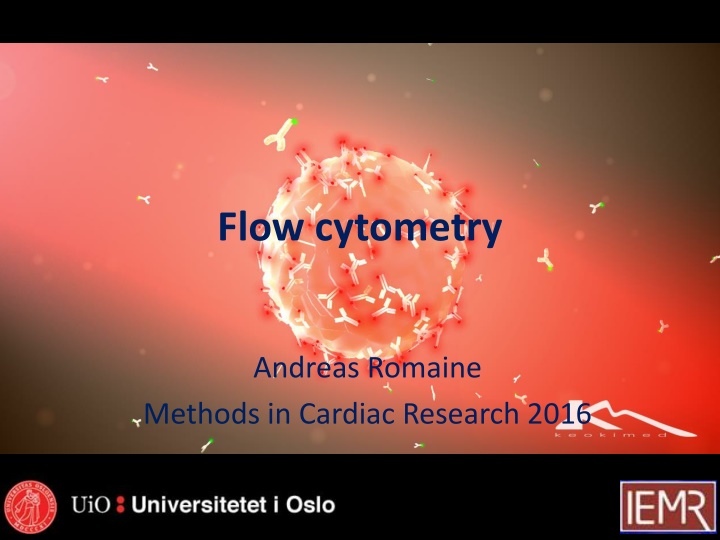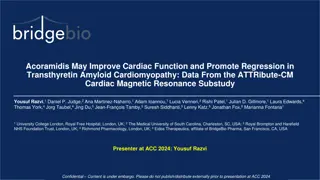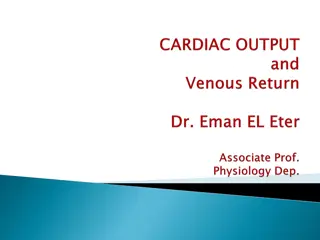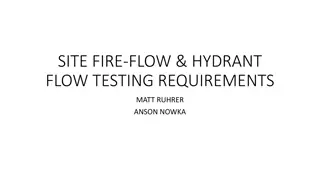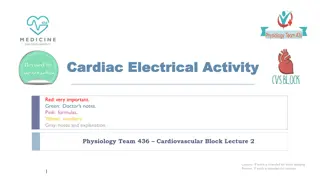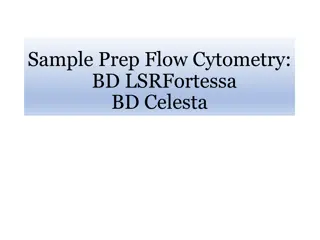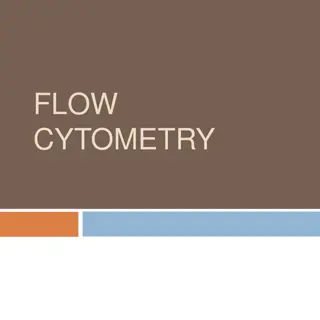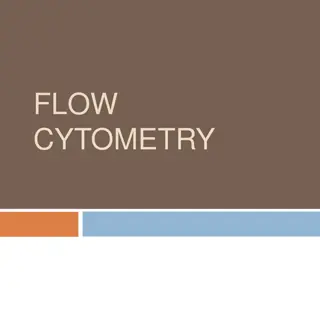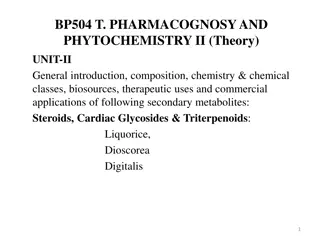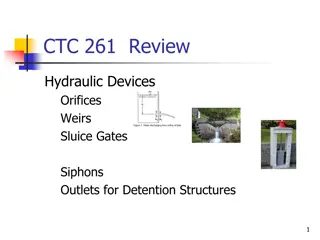Flow Cytometry in Cardiac Research: Methods and Applications
Flow cytometry is a laser-based system used to measure the properties of individual cells, such as size, granularity, and fluorescence intensity. It enables the comparison of multiple cell markers on individual cells, making it valuable in cardiac research for understanding cell populations and protein expression.
Download Presentation

Please find below an Image/Link to download the presentation.
The content on the website is provided AS IS for your information and personal use only. It may not be sold, licensed, or shared on other websites without obtaining consent from the author.If you encounter any issues during the download, it is possible that the publisher has removed the file from their server.
You are allowed to download the files provided on this website for personal or commercial use, subject to the condition that they are used lawfully. All files are the property of their respective owners.
The content on the website is provided AS IS for your information and personal use only. It may not be sold, licensed, or shared on other websites without obtaining consent from the author.
E N D
Presentation Transcript
Flow cytometry Andreas Romaine Methods in Cardiac Research 2016
Overview What is flow cytometry? How does it work? Applications Considerations for your project Questions?
What is it? Laser based system that measures the properties of single cells Measures the size, granularity and fluorescence intensity of cells and particles Can compare the expression of multiple cell markers on individual cells
Flow cytometers Becton-Dickinson Fluorescence activated cell sorter (FACSCalibur) Becton-Dickinson ACCURI C6
How it works 1. Light scatter detection (antibody independent) 2. Fluorescence detection 3. Combining parameters and Gating 4. Multicolour flow cytometry and Compensation
Forward and Side Scatter Sheath fluid flow Forward light scatter (FSC)- size Side light scatter (SSC)- granularity Laser light source Scattered light Detector
Forward and Side Scatter Cell populations can be distinguished based on size and granularity
Antibodies and Controls Antibodies are raised in a host species against single (monoclonal) or multiple (polyclonal) epitopes Antibodies can have varied specificities and affinities Isotype controls are antibodies raised in the same host species but with irrelevant epitope specificity Variable region Constant region Sheep anti mouse protein A Sheep anti mouse protein B Variable region Constant region
Fluorescence detection Fluorophore Antibody Fluorescence Detector Laser light source
Fluorescence detection Fluorescence intensity is proportional to the expression of the protein/particle of interest Cells can be fixed and permeabilized to assess intracellular expression Extracellular and intracellular expression can be distinguished by quenching (uptake experiments) Mean fluorescence intensity http://t2.gstatic.com/images?q=tbn:ANd9GcTMbJSz4Auc0xR_sZOczzAlNydsi4TmkYY3lFf6vx6HfUn6OM4dXw
Fluorescence detection Excitation (Ex) The wavelength the flurochromes are excited by Blue laser 488nm or Red laser 640nm
Gating http://t2.gstatic.com/images?q=tbn:ANd9GcTMbJSz4Auc0xR_sZOczzAlNydsi4TmkYY3lFf6vx6HfUn6OM4dXw Gates are used to select cells of interest, based on FSC/SSC or fluorescence or even a combination http://t2.gstatic.com/images?q=tbn:ANd9GcTMbJSz4Auc0xR_sZOczzAlNydsi4TmkYY3lFf6vx6HfUn6OM4dXw Reverse gating
Direct vs Indirect staining 2 conjugated ab 1 ab 2 conjugated abs larger selection of fluorochromes that can avoid compensation issues Amplifies signal 1 conjugated abs Pros Faster Fewer wash steps= more cells Cons Can be more expensive Limited fluorochrome selection Not always available Avoiding species cross reactivity More wash steps
Compensation FL3 FL2 FL1 Bleeding of FL1 signal into FL2 channel
Applications 100% 41% Non transfected Plasmid GFP Adenovirus GFP Quantification of transfection efficiencies
Applications Results show 55.8% of the live cells are SDC4+Itga11-, whilst 31.9% of cells are double positive for SDC4 and Itga11 Gates are based on isotype controls or secondary antibody only controls
Applications Colocalisation- BRET Cell sorting
Western blotting FACS Confocal microscopy Throughput high high low Cellular localization v. poor ok v. good Simultaneous staining No Yes Yes Small samples No Yes Yes Lost Short term Sample storage Long term
Considerations Check the specificity of your antibody first Fluorochrome selection be aware of the Ex. available on your cytometer and of spectral overlaps in Em. Choose brightest fluorochromes for lowest expressing target proteins Cross reactivity of secondary antibodies Keep the cells alive or fix, but be consistent Include controls with every capture
